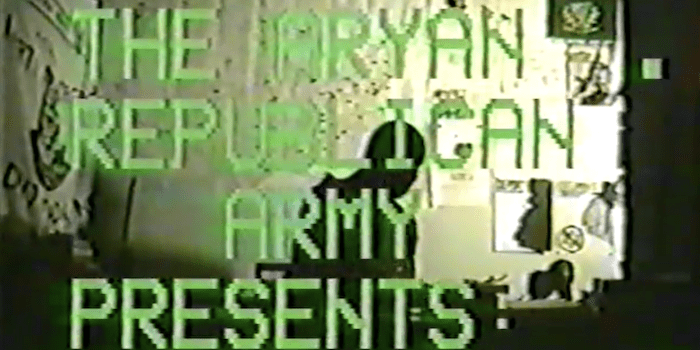(Ken Silva, Headline USA) This Friday marks the 29th anniversary of the Oklahoma City bombing, which killed at least 168 people, including 19 children in the deadliest domestic terrorist event in U.S. history.
While that attack may seem like ancient history for some, one attorney in Utah continues to pursue lawsuits against the Justice Department for records about it. The attorney, Jesse Trentadue, thinks that others helped the supposed “lone wolf,” Timothy McVeigh. Specifically, Trentadue has implicated the Aryan Republican Army, or ARA, a gang of neo-Nazi bank robbers who were operating around the same time as McVeigh.
Contrary to Trentadue’s theory, U.S. Attorney General Merrick Garland, who helped prosecute McVeigh, continue to insist that the bomber acted alone—receiving only minor help in gathering explosives material from accomplice Terry Nichols.
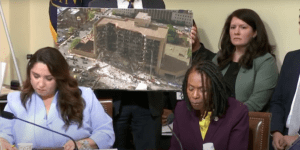
Garland and the other officials insist there was no link between the ARA and McVeigh. Their media mouthpieces, such as the Washington Post, have said the same. Amidst the ARA and McVeigh’s criminal proceedings in 1997, the Post declared there was “no proof that McVeigh knew the Aryan robbers.”
But the records provided by Trentadue indicate otherwise. Those records show that the FBI also thought McVeigh and the ARA were in cahoots.
One set of previously unpublicized records provided by Trentadue even shows that the FBI directed its field offices to investigate potential McVeigh-ARA links within days of the April 1995 attack. The records are briefly referenced in an epic biography of McVeigh, but have otherwise remained hidden for the last nearly 29 years—until now.
OK Bomb Rob
According to the records provided by Trentadue, the FBI launched a nationwide investigation into ARA-McVeigh links on April 27, 1995, directing field offices across the country to review their unsolved bank robberies to see if see whether McVeigh was involved.
The FBI was investigating McVeigh’s involvement in bank robberies because, among other reasons, his accomplice Nichols was found with $5,000.
Furthermore, investigators obtained a letter McVeigh wrote to his sister on Dec. 14, 1993, saying that he had a friend who “knocks over banks” and orchestrates credit scams. In that letter, McVeigh said, “We have to fund out war efforts with sometimes, covert means. We operate no different than the American underground in Nazi Germany.”
McVeigh’s description was the exact modus operandi as the ARA, which committed at least 22 bank robberies in the mid-90s—all with the goal of funding a right-wing revolution. The ARA even engaged in the credit scams described by McVeigh, with ARA leader Richard Lee Guthrie using false identification to rack up charges on stores cards from JC Penny’s, Sears, Montgomery Ward and others.
Over the next several months, FBI field offices across the country looked at their unsolved bank robberies and generated reports for the OKC bombing investigators.
Most of the reports downplayed any potential involvement by McVeigh or his associates. San Francisco’s FBI office, for example, found that five of its recent robberies were committed by a long-actor who “only began [robbing banks] after his wife left him for her lesbian lover.” The FBI Norfolk office, meanwhile, had two unsolved robberies that were both committed by an unidentified black man—ruling him out of a neo-Nazi conspiracy.
However, other offices produced potential hits on their search for a link between McVeigh, bank robberies and the ARA. One office went as far as to name McVeigh as a suspect in a string of robberies in Sioux Falls.
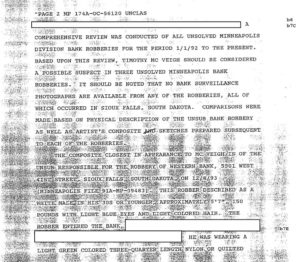
“TIMOTHY MC VEIGH SHOULD BE CONSIDERED A POSSIBLE SUSPECT IN THREE UNSOLVED MINNEAPOLIS BANK ROBBERIES. IT SHOULD BE NOTED THAT NO BANK SURVEILLANCE PHOTOGRAPHS: ARE AVAILABLE FROM ANY OF THE ROBBERIES, ALL OF WHICH OCCURRED IN SIOUX FALLS, SOUTH DAKOTA,” a May 3, 1995, teletype from the FBI’s Minneapolis office stated.
Another FBI office, this one in Louisville, responded to the FBI’s directive with a June 1995 report on a bank robbery that had happened on May 10, 1995. McVeigh was already in jail by that time, but the May 10 robbery was committed by the ARA.
Along with reviewing unsolved robberies for evidence of McVeigh’s involvement, the FBI also mapped McVeigh’s travels around the country to compare when and where he was during the ARA’s various robberies.
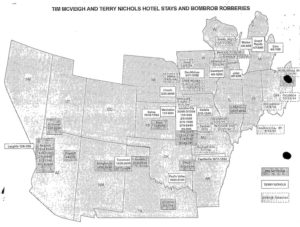
While the FBI map didn’t show McVeigh being in any city during an ARA robbery, criminologist Mark Hamm has shown that he and the ARA were in various locations at the same time throughout 1993 and 1994.
“It is highly improbable—if not statistically impossible—for nine men with such violent predispositions and such deep connections within the white power movement … to randomly come together at the same time in the same geographical area,” Hamm has argued, referring to McVeigh, Nichols, Guthrie, Langan and five other Aryan members.
ARA Arrests
In January 1996, the FBI arrested ARA leaders Guthrie and Peter Langan. Other members, including Kevin McCarthy, Scott Stedeford and Mark Thomas, were also arrested around that time.
However, none of them were charged for being involved in the OKC bombing.
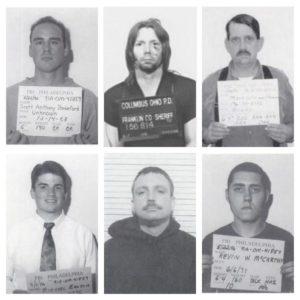
Shortly after the arrests, ARA leader Langan began implicating his former associates. During his criminal proceedings, Langan subpoenaed ARA member Thomas to testify about McCarthy’s role in the bombing.
Unfortunately for Langan and those seeking the truth, Thomas was indicted in the Eastern District of Pennsylvania a week before he was set to testify, thus cancelling his appearance at the Langan trial.
“With that, Kevin McCarthy became a protected government asset, and the FBI abandoned the entire McVeigh-ARA connection,” noted criminologist Hamm in his book on the ARA, In Bad Company.
Langan was convicted of five bank robbery-related charges in 1997, and sentenced to life without the possibility of parole. His cohorts received lighter sentences: 30 years for Stedeford, five years for McCarthy (as part of a plea deal where he testified against Langan), and 57 months for Brescia.
Guthrie, for his part—the person who purportedly told Langan about the other ARA members’ connections to OKC—was found hanging dead in his prison cell in July 1996.
All that didn’t stop Langan from trying to reveal the ARA-OKC connections about six years later, this time in the state trial of Terry Nichols, who helped McVeigh construct the Ryder Truck bomb but wasn’t in Oklahoma on the day of the attack.
Prosecutors objected to Nichols using Langan as a defense witness to testify about the ARA-OKC connections. At a hearing over the matter, FBI agent John Hersley testified that it was impossible for McCarthy to be involved in the bombing because he was in Iowa on April 19, 1995.
In doing so, Hersley contradicted McCarthy’s own alibi that he was with Langan in Kansas. Nevertheless, the judge accepted the FBI agent’s testimony and rejected Langan from testifying for Nichols.
Langan tried once more to introduce evidence about the ARA’s connections to the OKC bombing in his aforementioned sworn court statement in a lawsuit by Utah attorney Trentadue. But Trentadue’s case, too, was dismissed in 2010.
Since then, Langan has transitioned from trying to reveal information about the OKC bombing to championing transgender rights. As Headline USA has extensively reported, Langan became the first federal inmate in history to receive a sex change last year.
Hamm and others have speculated that the FBI never prosecuted the ARA for the OKC bombing because the group was infiltrated with government informants, including Langan and another member named Shawn Kenny.
“The real problem for the government … was the embarrassing fact that the Secret Service had sprung [Langan] from jail back in 1993; after that, of course, he went on to form the Aryan Republican Army. And the weight of the evidence suggests that the Aryan Republican Army did, in the final analysis, play a direct role in the plot to bomb the Oklahoma City federal building,” Hamm wrote in his book.
The Investigation Continues
Meanwhile, Trentadue continues his investigation into the ARA’s involvement.
Like Hamm and others, the Utah attorney believes the DOJ is whitewashing the ARA’s involvement in OKC because of the criminal activity from the government’s own informants. Trentadue has gone as far as alleging in court records that the ARA was an FBI front group.
“Timothy McVeigh participated in some of those robberies and is reported to have used money obtained from these crimes to help fund the bombing of the Murrah Federal Building in Oklahoma City on April 19, 1995. Members of the ARA also assisted McVeigh in carrying out the bombing of the Murrah Federal Building,” he said in a lawsuit filed in February.
“The ARA was actually a front group created by the FBI in which the Bureau had embedded at least one informant.”
Former FBI agents who investigated the OKC bombing have also linked the ARA to McVeigh. Danny Coulson, who headed the FBI’s hostage rescue team and worked on the OKC case, recently said that McVeigh had, in fact, visited the ARA’s hideout at Elohim City—debunking the Post’s earlier claim that there was “no proof” linking the two. Coulson has publicly called for the case to be reopened.
Coulson, and possibly Trentadue, are expected to be seen in an HBO documentary about the bombing that premiers Tuesday.
A previous version of this story incorrectly reported that McVeigh was found with $2,000 cash when he was arrested. That information came from an FBI report that turned out to be false.
Ken Silva is a staff writer at Headline USA. Follow him at twitter.com/jd_cashless.

